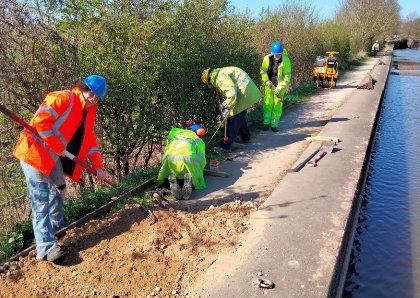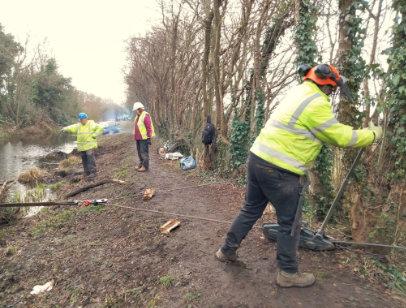








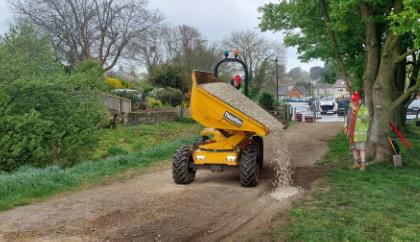
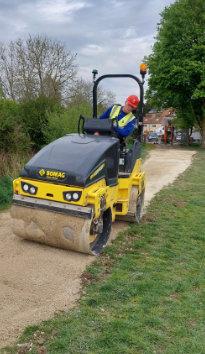
As we went to press the first week-long Waterway Recovery Group Canal Camp of 2025 had just taken place on the River Parrett in Somerset. The work for the Camp was laying and improving paths in Langport as a way of providing better access for local people to the river. It’s part of a programme supported by the local branch of the Inland Waterways Association which aims to also improve access for boating on the river, currently largely restricted to small craft. We hope to have a Camp Report next time. The pictures by David Miller show the start of spreading and rolling and the leadership team hard at work planning the Camp.
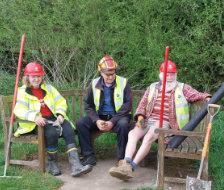
For latest news on our activities visit our website wrg.org.uk
See Facebook group: WRG
Contents
Editor’s Welcome Restore or maintain? 4
Letters to the editor 5
Chairman’s Comment Aligning restoration schemes with 12 benefits for the nation 6-7
Comingsoon Last call for training 8-9
Cleanup Report from the BCN 10-13
London WRG A year in the life 14-17
Diary Camps and working weekends 18-19
Nature & restoration Part 2: wildlife-friendly ways of restoring canals 20-23
Logistics What’s a Container Day? 24-26
Progress around the system 27-33
News Possible reunion dig? And does your canal need some bentonite? 34-35
PLEASE NOTE: subscriptions renewal cheques should be made out to The Inland Waterways Association. Note new address (right)
Follow us on @wrg_navvies
Editor: Martin Ludgate, 35 Silvester Road, East Dulwich London SE22 9PB. 020-8693 3266 martin.ludgate@wrg.org.uk
Contributions welcome, by email or post, to the address above. If sending a lot of large picture files, please contact the editor first. Pressdateforissue331:15May.
Subscriptions: Ayear'ssubscription(6issues) isaminimum of £5.00 (please add a donation if you can) to WRG, Unit 16B, First Floor, Chiltern Court, Asheridge Road, Chesham HP5 2PX. Cheques must be made out to The Inland Waterways Association (although the proceeds will be put to WRG / Navvies use).
Distribution: John Hawkins, 4 Links Way, Croxley Green WD3 3RQ 01923 448559 john.hawkins@wrg.org.uk
Navvies is published by Waterway Recovery Group and is available to all interested in promoting or supporting the restoration and conservation of inland waterways by voluntary effort in Great Britain. Articles may be reproduced in allied magazines provided that the source is acknowledged.
WRG may not agree with opinions expressed in this magazine, but encourages publication as a matter of interest. Nothing printed may be construed as policy or an official announcement unless so stated - otherwise WRG and IWA accept no liability for any matter in this magazine.
Waterway Recovery Group is part of The Inland Waterways Association, (registered office: Unit 16B, First Floor, Chiltern Court, Asheridge Road, Chesham HP5 2PX), a nonprofit distributing company limited by guarantee, registered in England no 612245, and registered as a charity no 212342. VAT registration no 342 0715 89.
Directors of WRG: Rick Barnes, George Eycott, Helen Gardner, John Hawkins, Dave Hearnden, Nigel Lee, Mike Palmer, George Rogers, Jonathan Smith, Harry Watts.
ISSN: 0953-6655
© 2025 WRG
Cover picture: Adrian proudly displays the sizeable chunk of car that he had just pulled out of the Birmingham Canal Navigations Old Main Line during the annual BCN Cleanup - see report on pages 10-13. Back cover: Our regional group London WRG’s volunteers are pictured surfacing the towpath below Lock 26 at Tamworth Road on the Lichfield Canal (above) and extracting tree stumps from the canal bed at Uffington on the Shrewsbury & Newport Canals (below). See pages 14-17 for a roundup of London WRG’s activities since January 2024. Pictures by Martin Ludgate
Should we do more maintenance and less restoration? We hear from Navvies readers and IWA and CRT representatives. What do you think?
…to another issue of Navvies, the magazine of Waterway Recovery Group, written by and for those interested in volunteer work on restoring the inland waterways of Britain, which takes its name from the original ‘navvies’, itinerant labourers who travelled around the country 200 years ago seeking work on building the canals.
And if you read my editorial column in the last issue, you may recall that one thing I touched on was whether, instead of - or perhaps in addition to - restoring or building canals around the country, we might consider spending some of our time and effort helping to maintain the ones we’ve already got. After all, it’s not going to be much use restoring (say) the last missing eight miles of the Chesterfield Canal if by the time we finish it, the other 38 miles are falling into disrepair for lack of money and effort to keep them in good nick.
And that’s a very real possibility - particularly given that the Government’s public funding plan the Canal & River Trust (which is responsible for maintaining most of the waterways network) for 2027 to 2037 will see the annual grant reduced every year to a level that won’t be enough to keep the network open unless new sources of cash are found and/or major economies can be made. But on the other hand, it would be a real shame to abandon work on longstanding restoration projects, only to find - say 10 years down the line, when (fingers crossed, touch wood) we’ve somehow found a way to keep the network open - that those restoration projects have deteriorated and are now beyond hope.
Is there a balance to be struck? I’ve had couple of letters (see opposite) in response to my editorial last time, and I also picked up on a few relevant comments at the recent annual Waterway Restoration Conference, held jointly by WRG’s parent body the Inland Waterways Association and CRT, which I quote here...
Sean McGinley, CRT national lead on restoration: We see more passion for restoration than maintenance. I would like a better balance. But I don’t think anyone’s anti-restoration.
Juie Sharman, CRT chief operating officer: It’s not a binary choice.
Sean McGinley, CRT: The Government says “You [waterways] are good value for money. But we haven’t got any.”
Mike Wills, IWA Chair: The waterways haven’t been properly funded in our lifetimes, not in our parents’ lifetimes, perhaps not in our grandparents’ lifetimes. That’s never stopped us restoring canals.
Do you have a view on the subject? If so, please send it to Navvies and we’ll publish it in the next issue.
And still on that topic, elsewhere in this issue you can read a report from the BCN Cleanup, which is an annual event where we do exactly what Roger Nuttall proposes in his letter (opposite), “support work for the Canal & River Trust on underused canals”. Once a year many WRG volunteers forsake our favourite restoration projects for a weekend of throwing hooks into the underused parts of the Birmingham Canal Navigations, pulling out bikes, trolleys, tyres, prams and some items that defy identification, to keep the system open and usable.
This year’s was a particularly successful event in terms of the numbers of volunteers, and we’ve already got a date (14-15 March 2026) and a proposed site (The Daw End Branch Canal) for next year’s Cleanup. Put it in your diary now!
Martin Ludgate, Navvies
editor
“Idowonderwhetheritwouldbepossibletodomoresupportworkforthe Canal&RiverTrustontherestoredbutunderusedcanals?”Doyouagree?
Dear Martin
Navvies is always a good read, but the latest (Issue 299, Feb-Mar 2025) is a cracker .The Editor asks why we bother to keep going when there is so much stacked against us. He mentions the latest breach (on the Bridgewater), where the canal is owned by a wealthy organisation, which is tight with money. So it is with most of the system. That is to say, the government.
Continuing the theme, our Chairman urges us to read the magazine, and become involved.
But why should we bother, when government (on behalf of the owners) does not? The answer is that we are one of the few rays of hope. We have a Chairman and Secretary who give us true leadership, backed by a knowledgeable, capable and committed board of Directors. The exact opposite of the lot in government. We need the, “let’s show ’em” attitude, and to set to and show them there is hope.
The canals belong to the people, where each and every one of us is a part owner. Take this message out there. We people on the ground can make a difference if we take an interest.
Jim Buckley
Dear Martin
Thank you for your thought-provoking editorial. Herewith a few thoughts from a long-time supporter now in my ninth decade.
First, on parochial matters. Whilst I hugely admire the work which WRG do, I do wonder whether it would be possible to do more support work for the Canal & River Trust on the restored but underused canals? I still manage to walk around the system, and I cannot help but notice the poor condition of much of the Rochdale and the Huddersfield Narrow: numerous locks with few paddles working and those that are, are stiff with the lack of grease / oil. Secondly, you ask for our views on the more general climate change / environmental side of our work. My instinct is to join in the work of environmental organisations such as Greenpeace. At the end of the day (forgive the cliche) we are all pointing in the same direction, but we need all the support we can find for the drastic underfunding of the waterways.
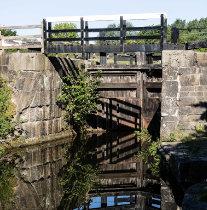
Given their condition, should we consider putting more into supporting navigable canals such as the Rochdale, pictured?
Anyway, many thanks indeed for all that WRG does and more power to your elbow.
Yours
OntheIWA’sWaterways for Today report,andwhyMikebelievestheway forward is for restoration schemes to align themselves with its 12 aims…
Yesterday (as I write this) was the 2025 Waterway Restoration Conference, organised by IWA and CRT (that’s Waterway Recovery Group’s parent body the Inland Waterways Association, and national navigation authority the Canal & River Trust, to any new readers). It’s an annual event, this year in the wonderful Ellesmere Port Boat Museum, where all sorts of interesting topics are covered and, crucially, both IWA and CRT can give the entire waterway restoration sector any messages they feel are important. My view is that if these messages are important enough to feature at the Restoration Conference then they should also feature in Navvies, because, if there is one thing we know about the readers of Navvies, it is that they (a) come from a wide range of organisations throughout the sector, and (b) are genuinely interested in new discussions (or perhaps old discussions that have come around again).
My part in the proceedings had the title of Restoration – Moving Forward which was vague enough to allow my considerable imagination to flow and, for the reasons given above re: Navvies readers, I’m going to pinch a chunk of my presentation for this Comment column. First of all, I started with the context in which I was speaking, namely two reports: Britain’s Inland Waterways: An Undervalued Asset from the Inland Waterways Amenity Advisory Council (1995) and Waterways for Today from the Inland Waterways Association (2022) An Undervalued Asset concluded with these words:
Firstly, in its inland waterways system, Britain has a national treasure, an asset of great historic and environmental value and a resource for a whole variety of beneficial uses. Secondly that this system having survived, for the most part, for two hundred years, national policy must ensure that it is sustained, not as a museum piece, but as an active working heritage giving pleasure and value to future generations.
Britain's system of inland waterways is a national asset of unique and outstanding quality. It exists not just to provide pleasure for today’s citizens; we are trustees of a splendid though undervalued inheritance. The nation should cherish and conserve it, restore and improve it, so that for another 200 years, future generations may also enjoy it and say approvingly, “They looked after it well!”
Which is of course very true but Britain has lots of national treasures (David Suchet for example!) and it doesn’t automatically lead to them being “sustained”. Which is why Waterways for Today is so important. Because this second report takes the suggestion that this national treasure is “a resource for a whole variety of beneficial uses” and goes so far as to name those benefits and to give strong, independent evidence for each of them. For completeness those benefits are:
Economic
Benefit 1 - Contributing to the country’s economic recovery
Benefit 2 - Increased spend in local communities
Benefit 3 - Savings to the NHS budget
Natural and built environment
Benefit 4 - Protecting and improving the natural environment
Benefit 5 - Saving waterways heritage for future generations
Benefit 6 - Sustainability: planning for resilience and climate change
Benefit 7 - Connecting communities
Benefit 8 - Education and young people
Benefit 9 - Jobs, training and apprenticeships
Improving Peoples’ lives
Benefit 10 - Improved physical health
Benefit 11 - Improved mental health
Benefit 12 - Creating better places to live
Having provided the evidence for these benefits, IWA goes on to state that the UK waterways form a vast national infrastructure network. They should not be considered an interest only of a ‘niche’ sector of boaters, anglers, canalside businesses, etc. They are providing benefits for the whole of the UK nations and, as such, they are relevant to everyone, even the legendary ‘man on the Clapham omnibus’.
So that is the current campaign – all waterways (whether navigable, in restoration or new) are relevant to the whole of the UK, whether they use them or not, and those waterways are deserving of greater, more consistent support. We should all want a ‘National Waterways Network’ in the same way we want a ‘National Rail Network’ for example.
This standpoint leads to two outcomes that affect our restoration sector:
Better, more stable funding during the restoration (because to fail to provide that funding is to deny the whole of the country the benefits that will come from it).
Then, and this is the best bit, when it is nearing completion, it should be much easier to find the funding that is going to make it sustainable.
Because let’s face it – that must be the ultimate goal of every Navvies reader - making sure our work lasts both well and forever.
By now I reckon you are thinking “uh oh – there is a ‘but’ coming, isn’t there?”. I’d like to think of it as an ‘and’ not a ‘but’. Because, while it may be possible that some work is placed off limits, as the restoration societies check that their plans for that work are aligned with fulfilling the benefits of Waterways for Today, it should only be a short blip, and it is probably going to be on the (current) edges of our work.
Now for the AND: because there are some significant discussions to be had as we all thrash out what “align with the benefits of Waterways for Today” means AND I reckon they are all good subjects for Navvies (I refer you to my original comments re: the readers of Navvies). The discussion on Benefit 4 (‘Protecting and improving the natural environment’) has already started in the previous edition with the first of Alex Melson’s articles on canal restoration and nature; a second one follows in this edition. Following on from a discussion with Ian McCarthy at the Conference, the discussion on Benefit 5 (‘Saving waterways heritage for future generations’) will start in the next edition.
Yes – I miss the good old days when we were best described as fanatics… but I am much more excited by the concept of our nations’ historic waterway network being considered by everyone to be a vital part of the nations’ infrastructure.
Mike Palmer

Last call to book for the Training Weekend and Leader Training Day; and meanwhile there’s another side added to the Camps programme…
The annual Training Weekend returns to the same central site at Lichfield for 2025 and we are very grateful to our friends at the Lichfield & Hatherton Canals Restoration Trust who have made this possible for us once again. All training sessions will take place on Saturday 17th and Sunday 18th May, with accommodation available from Friday evening for those wishing to stay over.
Fosseway Heath is a fantastic site, providing us with the perfect place to give volunteers some experience of the wide range of skills that will be useful on working weekends and camps. Our aim is to provide initial or refresher training in those areas which have been identified as priority for projects in the coming year, as well as instructor training for those with years of regular operator experience. Training will be available in the following areas:
• 360-degree excavators
• Articulated dumpers
• Ride-on rollers
• Minibuses
• Trailers
• Site tools
• Bricksaws
• Bricklaying
…as well as any other useful sessions identified over the next few months.
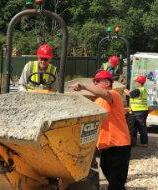
For those of you who have never attended a WRG Training Weekend, it is ideal for anyone attending a Canal Camp this year where specific skills have been identified as useful by your leaders, or perhaps you volunteer regularly and need certain skills for a particular local project to progress. Equally, returning volunteers may feel they need refresher sessions before the camp season starts. Perhaps you are considering becoming an instructor? Or, if you are already an instructor and able to volunteer and share your knowledge over the two days, please do get in touch. If you would like to book on, discuss opportunities or volunteer as an instructor, please do contact me via email: wrgtraining@wrg.org.uk
I look forward to hearing from you.
Ali Bottomley
This year’s Leadership Teams Day (LTD) is on Saturday, 31 May at its traditional location of Rowington Village Hall, Rowington Green, CV35 7DB near Warwick and starting formally at 10:00.
Existing and aspiring WRG Canal Camp leaders, assistant leaders and cooks are invited to attend, as are those involved in leading the regional and other mobile groups. Those making up the WRG leadership teams for this year’s Canal Camps are very strongly
encouraged to attend. Those who lead work parties for canal trusts are also very welcome to attend to share and compare their experiences against WRG’s.
Breakfast rolls will be available from 09:30 and lunch and a dinner will be provided on the day. The hall is available on the Friday evening for those not wishing to travel on the Saturday morning and also for Saturday night sleepovers so WRGies can attend the WRG Committee Meeting on the Sunday morning to learn more about the administration and operation of WRG.
There will not be a meal provided on the Friday evening but the hall kitchen will be available and there is always the Tom o’ The Wood pub a short walk down the road where decent food can be had. Best to book if you want to eat.
The day’s programme will be concentrating on updating Leadership Teams with all sorts of matters relevant to running safe, happy and successful camps in 2025.
The draft programme currently has these sessions in mind:
• WRG Standards for Leadership Teams and Key Messages from the WRG Board
• Assistant Leaders
• Environmental Considerations for Restoration Work and Canal Camps
• Reporting of Incidents, Accidents and Near-Misses
• Developing Risk Assessments
• 2025’s Camps
If leaders have anything on their minds that would be useful to discuss and investigate further, then please let me know via Verena in WRG HQ – verena.leonardini@waterways. org.uk
It will be a very useful, even essential, day for this year’s Leadership Teams to increase their awareness of useful and mandatory matters. The day will go a long way to making sure the Leadership Teams are fully prepared and able to justify their actions should the need arise.
Please book on via the WRG website. There is no charge!
David (‘Evvo’) Evans
In the last two issues of Navvies we previewed this year’s programme of week-long WRG Canal Camps, so there’s not a great deal more to add, other than that we’ve added one more site to the list…
The Neath Canal in South Wales, along with its neighbour the Tennant Canal, saw some successful restoration work back in the 1980s and 1990s and the establishment of a tripboat operation. Unfortunately more recently it has fallen on hard times, progress stalled, and it was in danger of falling back into dereliction.
However with the establishment of the new local Ty Banc Canal Group in recent years and with local authority support, there are prospects of putting the restoration back on track, and we’re supporting this with a week’s Canal Camp on 23-30 August.
The Camp will be working on the length of canal leading north from Resolven Basin, upgrading two water overflow points, including excavating the towpath, installing a concrete foundation and building a trough in concrete blockwork. This will be capped with concrete lintels and the towpath locally improved. At a second site further up the canal, work will also take place on fabricating and installing two timber lock tail bridges.
The work will coincide with the Canal Group’s festival at Resolven Basin, and will help to promote the restoration.
In the long term, the hope is that both the Neath and Tennant canals can be reopened, and connected to a restored Swansea Canal to create a local waterways network iin this part of South Wales.
Meanwhile as we went to press many of our Canal Camps were already fully booked; however it may be worth contacting Head Office regarding any placed made available as a result of cancelled bookings.
A good turnout of volunteers made for a successful weekend of clearing junk from the Birmingham Canal Navigations, as Chris Morgan reports…
The Birmingham Canal Navigations (BCN) are a 100-mile network of formerly heavily industrial canals covering the Birmingham, Wolverhampton, Walsall and Black Country area. They’re not everybody’s idea of holiday cruising (although they have their share of hardcore boating fans who will defend them in any comparison with the delights of the Llangollen Canal, southern Oxford etc) but they are a fascinating reminder of the area’s industrial past, and also a priceless asset for today’s canalside communities. And unfortunately they’re also a receptacle for a fair amount of rubbish, old bikes, prams, supermarket trolleys and the like, courtesy of the minority of locals who abuse them in this way. This can give them a bad reputation among boaters, which means fewer people cruise the canals, and this lack of use in turn leaves them unkempt, unloved, and attracting even more junk. Ultimately this could result in the canals becoming unusable and closing.
To break this vicious circle of decline, the annual BCN Cleanup, organised jointly by WRG and local canal groups with support from the Canal & River Trust, targets particularly bad areas (as reported by local boaters) and blitzes them with an army of volunteers wielding grappling hooks, supported by other teams with litter-pickers and on workboats to pick up all the rubbish retrieved. And they usually find some interesting stuff too! It’s actually an enjoyable weekend, a change from restoring derelict canals, and over the 28 years since it started, it’s made a real contribution to keeping these underused waterways going.
BCN Cleanup leader Chris Morgan reports from this year’s event…
The old Main line of the BCN from Tipton (Factory Locks) around to the Brades Locks Junction was the venue of this year’s canal dipping event!
Over 55 people attended, well up on previous years, ably supported by the BCNS (Birmingham Canal Navigations Society)
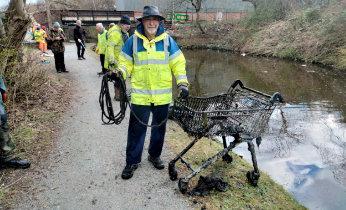
“Do you reckon Sainsburys will want it back?”
stalwarts with boats and crew, and the Canal & River Trust supplied one boat.
Our added attraction this year was that in addition to the usual grappling hooks to pull out rubbish, we were to do some offside vegetation cutting and rubbish picking in normally inaccessible areas. This we did with crews of volunteers in an old BCN open workboat towed along by Francis Herne on his powerful Sea Otter boat.
This work was (and continues to be) commented on very positively due to the opened up formerly obstructed bridgeholes and the sheer amount of litter removed. Well done all!!
Our overnight accommodation again was the Stables Outdoor Pursuit Centre, canalside in Tipton, where cook Lou produced some great grub for the hungry herd, while Ma Pardoe’s and Black Country

Ales on tap quenched their thirsts on Friday and Saturday evenings. A good time was had by all.
We have been asked by the new CRT organiser to look north for next year’s Cleanup, and possibly the Daw End Branch Canal for rubbish removal and cutting back. From my recent cruising experiences up there, I’d say “yes it needs it”, and should also involve a chipper!
So new accommodation next year, and new venue!
My thanks to ‘Moose’ for assisting and to Lou for cooking, many thanks to all the drivers and the groups that brought the vans and tools. Thanks to BCNS and Mike Anson for the loan of boat No 37.
Chris Morgan
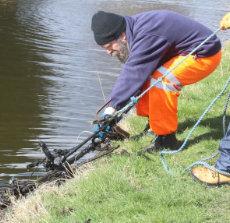
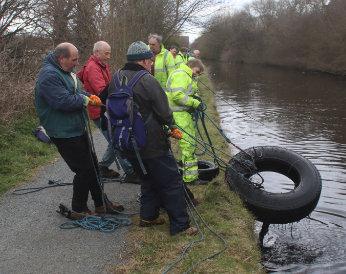
Possibly one of the biggest tyres we’ve ever pulled out

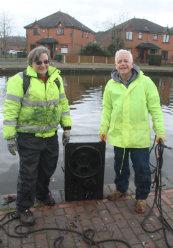
Remember when hi-fi speakers were this size?
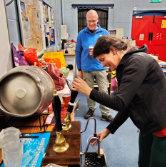
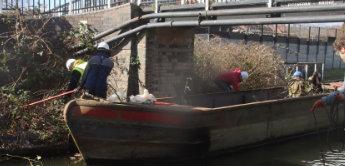
New job for this year: clearing overhanging vegetation on the offside of the canal
A year-and-a-bit in the life of London WRG, our mobile working party group based (very roughly) in the south east of England…
For our southern based WRG mobile weekend working party group, 2024 began (as do most years) with a weekend on the Chelmer & Blackwater Navigation, a waterway run by a subsidiary of WRG’s parent body the Inland Waterways Association. It’s a working waterway so there’s no restoration work to be done but plenty of maintenance to help with, including on this occasion removing dead timber, felled trees and overhanging branches from around Springfield Basin in Chelmsford. It was also noted that we were “somewhat delayed by sandwich making and realising that someone had eaten Tim’s breakfast”!
Our February dig was on the Cotswold Canals, where we had a variety of tasks including finishing off some brickwork on Dock Lock, which was partially restored some years ago, including the lower gate quadrants and steps, as well as scrub clearance in preparation of construction of the top end of John Robinson Lock and associated aqueduct.
In March we supported the BCN Cleanup, then in April it was the turn of the Wey & Arun Canal to receive our attention. The main task for this joint dig with our friends in Kescrg was channel wall reconstruction on the Loxwood Link restored section of canal, using environmentally friendly coir rolls and wooden stakes. Quote of the weekend: “If we do the backfill first, does that make it frontfill?”

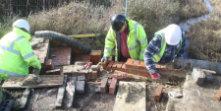

May saw us back on the Cotswold Canals again, continuing the work at Dock Lock including completing the gate quadrant. We also did some brickwork repairs at John Robinson Lock, levelled the towpath and dug out stumps.

Terry Cavender of the Buckingham Canal Society usually has something interesting for us, and the most interesting thing about our June weekend was that it wasn’t on the Buckingham Canal at all. We were carrying out a job for the Bedford & Milton Keynes Waterway Trust, but it wasn’t on the B&MKW either, mainly because they haven’t built it yet.
In fact it was on the Grand Union, where we were installing a service bollard and associated drinking water and electricity supplies for the B&MKWT’s tripboat. With no machinery access we dug it by hand - “It was like being a real Navvy but with less drinking and fighting”.
After a summer break we returned to the Cotswold Canals in September but a different site by Weymoor Bridge. We put up shuttering for a concrete channel wall being constructed where the canal crosses over a stream culvert (installed during the summer’s Canal Camps).


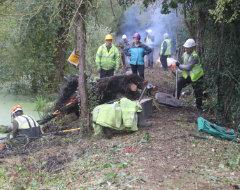
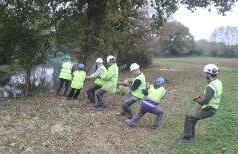
With the arrival of autumn the scrub-bashing season had begun, and in October we visited the Shrewsbury & Newport Canals, working on removing some very large stumps from the canal at a site near Uffington.
Plant access is tricky (there are overhead wires) so we either pulled them out with Tirfor winches or burned them in situ.
For our November dig we were back on the Wey & Arun, on another joint weekend with Kescrg clearing overhanging vegetation south of Loxwood.
And in December it was back to the Wey & Arun yet again, this time with both Kescrg an WRG Forestry, for a Christmas dig (with party fun and games on the Saturday evening).
The work was more scrub bashing, but including dealing with some sizeable trees which have succumbed to the infamous Ash Die Back disease and are giving the Canal Trust a lot of extra work in the Loxwood area at the moment.
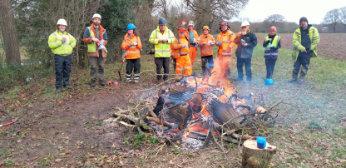
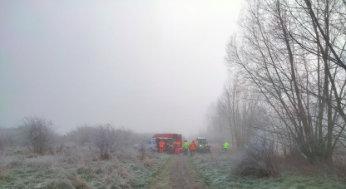

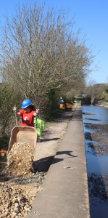
2025 began as 2024 did, with London WRG making our annual visit to the Chelmer & Blackwater Navigation on a chilly January weekend, this time working just outside Chelmsford with WRG Forestry, taking out some self-seeded willow trees to allow the remaining ones space to grow (and in due course, to be harvested to make cricket bats!)
In February we were back at Uffington on the Shrewsbury & Newport Canals, still attacking those reluctant tree stumps, but with the site starting to look more canal-like at last.
And after the BCN Cleanup (see elsewhere in this magazine) in March, April saw us on the Lichfield Canal. Our task there was to lay and roll a new surface on the towpath below the two restored locks at Tamworth Road (Borrowcop Locks) on the edge of Lichfield.
New volunteers are welcome on London WRG weekends (and transport can usually be provided from London) - see the diary pages for dates and contact details. Martin Ludgate
Week-longCanalCampscost£80orasstated.Bookingforeventslabelled‘WRGCanal AsheridgeRoad,CheshamHP52PX.Tel:01494783453,enquiries@wrg.org.uk.Diary
Apr30-May6 IWA/WRG SupportcampforiWACanalwayCavalcadefestivalatLittleVenice,London
May10-11 KESCRG Wilts&BerksCanal,PewshamLocks
May16-18, NWPG CotswoldCanals
May17-18, wrgBITM CotswoldCanals
May17-18 TW2024 WRGTrainingWeekend
May17-18 London WRG CotswoldCanals
May17-18 MBBCS Manchester,Bolton&BuryCanal:NobEndLocks(mightchangeduetoWRGTraining
May31Sat LTD LeadershipTeamsDay:RowingtonVillageHall
Jun1Sun WRG WRGCommittee/BoardMeeting:RowingtonVillageHall
Jun7-8 KESCRG Wey&ArunCanal,RooksBridge
Jun14-15 London WRG UttoxeterCanal:balsambashingweekend
Jun21-22 wrgBITM SuffolkStour
Jul5-12 WRG Canal Camp Wey&ArunCanalCampledbymobilegroupNWPG
Jul12-19 WRG Canal Camp Wey&ArunCanalCampledbymobilegroupKESCRG
Jul19-20 wrgBITM Tobearranged
Jul26-Aug2 WRG Canal Camp LichfieldCanalCampatTamworthRoad,Lichfield
Aug2-9 WRG Canal Camp LichfieldCanalCampatTamworthRoad,Lichfield
Aug9-16 WRG Canal Camp LouthCanalCampatTicklepennyLock
Aug9-16 WRG Canal Camp CotswoldCanalCampatWeymoorBridge
Aug16-23 WRG Canal Camp CotswoldCanalCampatWeymoorBridge
Aug23-30 WRG Canal Camp NeathCanalCampatResolven
Sep6-7 London WRG CotwoldCanals,WeymoorBridge.JointweekendwithKESCRG
Sep6-7 KESCRG CotwoldCanals,WeymoorBridge.JointweekendwithLondonWRG
Sep20-21 wrgBITM MaidenheadWaterways
Sep20-21 MBBCS Manchester,Bolton&BuryCanal:NobEndLocks
Sep28Sun WRG WRGCommittee/BoardMeeting:RowingtonVillageHall.NotedatechangedfromSat
Oct4-5 London WRG Shrewsbury&NewportCanals
Oct4-5 KESCRG Tobearranged
Oct17-19 NWPG Tobearranged
Oct18-19 wrgBITM BasingstokeCanal
Oct18-19 MBBCS Manchester,Bolton&BuryCanal:NobEndLocks
Nov15-16 wrgBITM MaidenheadWaterways
Nov15-16 MBBCS Manchester,Bolton&BuryCanal:NobEndLocks
Nov22-23 NWPG Tobearranged
Dec6-7 London WRG Wey&ArunCanal.JointChristmasdigwithKESCRGandWRGForestry
Dec6-7 KESCRG Wey&ArunCanal.JointChristmasdigwithLondonWRGandWRGForestry
Dec13-14 wrgBITM Tobearranged
Dec20-21 MBBCS Manchester,Bolton&BuryCanal:NobEndLocks
CanalCamp’ shouldgoto:WRGCanalCamps,Unit16B,FirstFloor,ChilternCourt, contributionstoDaveWedd,Tel07816175454mdave.wedd@wrgbitm.org.uk
Ed Walker
Trainingweekend)
07887-568029
ed@edwalker.org.uk
Bill Nicholson 01844-343369 bill.nicholson@weyarun.org
Dave Wedd 07816-175454 dave.wedd@wrgbitm.org.uk 01494-783453 enquiries@wrg.org.uk
Tim Lewis 07802-518094 london@wrg.org.uk
Sam Kennion 07843-394161 samklancs@yahoo.com 01494-783453 enquiries@wrg.org.uk 01494-783453 enquiries@wrg.org.uk
Ed Walker 07887-568029 ed@edwalker.org.uk
Tim Lewis 07802-518094 london@wrg.org.uk
Dave Wedd 07816-175454 dave.wedd@wrgbitm.org.uk 01494-783453 enquiries@wrg.org.uk 01494-783453 enquiries@wrg.org.uk
Dave Wedd 07816-175454 dave.wedd@wrgbitm.org.uk 01494-783453 enquiries@wrg.org.uk 01494-783453 enquiries@wrg.org.uk 01494-783453 enquiries@wrg.org.uk 01494-783453 enquiries@wrg.org.uk 01494-783453 enquiries@wrg.org.uk 01494-783453 enquiries@wrg.org.uk
Tim Lewis 07802-518094 london@wrg.org.uk
Ed Walker 07887-568029 ed@edwalker.org.uk
Dave Wedd 07816-175454 dave.wedd@wrgbitm.org.uk
Sam Kennion 07843-394161 samklancs@yahoo.com Sat27September 01494-783453 enquiries@wrg.org.uk
Tim Lewis 07802-518094 london@wrg.org.uk
Ed Walker 07887-568029 ed@edwalker.org.uk
Bill Nicholson 01844-343369 bill.nicholson@weyarun.org
Dave Wedd 07816-175454 dave.wedd@wrgbitm.org.uk
Sam Kennion 07843-394161 samklancs@yahoo.com
Dave Wedd 07816-175454 dave.wedd@wrgbitm.org.uk
Sam Kennion 07843-394161 samklancs@yahoo.com
Bill Nicholson 01844-343369 bill.nicholson@weyarun.org
Tim Lewis 07802-518094 london@wrg.org.uk
Ed Walker 07887-568029 ed@edwalker.org.uk
Dave Wedd 07816-175454 dave.wedd@wrgbitm.org.uk
Sam Kennion 07843-394161 samklancs@yahoo.com
How can canal restoration contribute to nature conservation? In the second part of his series, Alex Melson shows how it can be done…
Waterway restoration hasn’t always had the easiest of relationships with nature conservation. Sometimes as canal restorers wanting to reopen waterways for boating (and other compatible uses), we have found ourselves at loggerheads with wildlife interests who may see reopening to navigation (particularly by powered craft) as a threat to an important ecological asset. But that needn’t be the case. Depending on the methods used, restoration can actually benefit biodiversity at the same time as extending the navigable waterways network - and this can be used to gain wider support for canal reopening.
Alex Melson (who many of you may recall from his time as one of the IWA Head Office staff with responsibility for WRG matters - before moving on to pursue a career in nature and the environment) has returned as a volunteer contributor of a series of articles about wildlife and inland waterways.
In the first one, he explained why wildlife interests regard the waterways network as so important to biodiversity and nature conservation. This time he shows how restoration can contribute to the wildlife value of canals.
Canals, once engineered primarily for transportation and trade, are increasingly recognised for their role in maintaining and enhancing biodiversity. As more canals undergo restoration projects, there is a unique opportunity to design and implement strategies that not only return these waterways to their historical function but also improve their environmental value. Enhancing and improving the biodiversity of canals undergoing restoration requires a multifaceted approach that addresses habitat creation, water quality, invasive species management, community engagement, and long-term monitoring. This article explores key strategies for achieving these goals, ensuring that canals contribute to broader conservation and sustainability objectives.
A key aspect of canal restoration is the creation and enhancement of habitats that support diverse plant and animal species. Restoring natural features along the canal banks can have significant ecological benefits. The riparian zone—the land bordering the canal—plays a crucial role in supporting a variety of wildlife. The restoration of native vegetation along the water's edge is one of the most effective ways to enhance biodiversity. Planting native trees, shrubs, and grasses along canal banks can provide shelter, food, and nesting sites for a wide range of species, from insects to birds and mammals. Species such as willows, alder, and reedbeds are particularly valuable as they stabilise soil, reduce erosion, and help filter water.
Restoration projects can also focus on reintroducing aquatic vegetation. Many canals, particularly those that have been heavily modified or neglected, lack the diverse plant life necessary to support aquatic species. By replanting submerged plants such as water lilies, pondweeds, and elodea, canals can offer habitat for invertebrates, fish, and amphibians. These plants are crucial for water quality as they filter nutrients, stabilise sediment, and provide oxygen to aquatic environments.
The creation of wetlands and shallow ponds in or around canal systems is another powerful tool for enhancing biodiversity. Wetlands serve as critical breeding and foraging
habitats for many species, particularly waterfowl, amphibians, and invertebrates. Shallow ponds also act as buffer zones, absorbing excess nutrients and pollutants from the surrounding environment before they can reach the canal. By strategically placing these features in the canal’s surrounding landscape, restoration efforts can mimic the natural diversity of wetland habitats, fostering an environment that supports a wide array of species.
Water quality is a cornerstone of biodiversity. Many canals suffer from poor water quality due to pollution, agricultural runoff, or the accumulation of organic matter. To enhance the biodiversity value of restored canals, water quality must be improved to support healthy aquatic ecosystems. This can be achieved by reducing nutrient pollution and controlling sedimentation.
One way to improve water quality is by creating buffer zones with riparian vegetation along the canal. These plants help absorb nutrients from runoff, reducing the influx of harmful chemicals such as nitrogen and phosphorus that can lead to algal blooms and oxygen depletion. Additionally, using natural filtration techniques like reed beds or wetland plants can help absorb excess nutrients before they reach the water.
Restoring the natural hydrology of a canal is also critical for improving water quality. Canals that have been artificially deepened or straightened can have altered water flows that affect aquatic ecosystems. Restoring meanders, increasing flow variability, and promoting natural water levels can help create a more dynamic environment that supports a variety of aquatic species. Moreover, maintaining a balance of water levels throughout the seasons allows for habitat stability, supporting both aquatic and terrestrial life forms.
Invasive species pose a significant threat to biodiversity, and canal restoration projects must include strategies to control or eliminate non-native species. Invasive plants, such as Himalayan balsam, Japanese knotweed, and floating water plants like water hyacinth, can
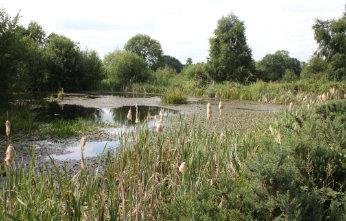
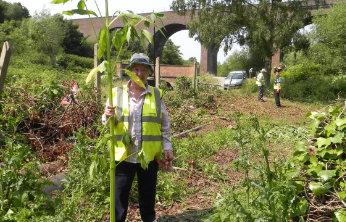
Dealing with invasive species: an IWA ‘Balsam bash’ under way
quickly dominate canal ecosystems, outcompeting native species and reducing habitat diversity. Similarly, invasive fish and invertebrates, such as the predatory signal crayfish, can harm local populations by preying on or outcompeting native species.
Effective invasive species management begins with early detection and rapid response. Regular monitoring of canal ecosystems allows for the identification of invasive species before they become well-established. Control methods may include mechanical removal, herbicide treatments (when appropriate), and the introduction of biological controls. For example, removing dense stands of invasive plants manually or with machinery can allow native species to re-establish themselves. For aquatic invasives, barriers or traps may be employed to limit the spread of species like invasive crayfish or fish.
Another strategy is to enhance the ecological resilience of native species, so they are better able to compete with or withstand the impacts of invasive species. This could involve reintroducing native plants and animals to create a more balanced and diverse ecosystem that can better resist the spread of invaders. For example, planting a diverse range of native aquatic plants can help shade out and compete with invasive species.
One of the most effective ways to improve biodiversity during canal restoration is by involving local communities, landowners, and stakeholders in the project. Community engagement ensures that restoration efforts are supported by those who live and work around the canal, making the projects more sustainable and meaningful.
Public participation can take many forms, from volunteering in planting and clean-up efforts to providing input on the design of the restoration project. Educational programs can help raise awareness of the importance of biodiversity and the role canals play in supporting ecosystems. These programs can also teach people about the specific species that benefit from canal restoration and encourage them to protect these habitats.
Collaboration with local environmental organisations, government agencies, and scientists can also contribute to the success of restoration efforts. These stakeholders can provide expertise on best practices for enhancing biodiversity and offer guidance on monitoring and adaptive management strategies.
Finally, a successful canal restoration project requires ongoing monitoring and adaptive management. Biodiversity does not always thrive immediately after restoration; ecosystems may take time to stabilise, and there may be unforeseen challenges, such as the reemergence of invasive species or changes in water quality
Establishing a comprehensive monitoring program is crucial for tracking the success of restoration efforts and identifying areas for improvement. This may involve regular surveys of plant and animal populations, water quality testing, and assessments of habitat conditions. Monitoring can help identify trends in biodiversity, ensuring that restoration efforts are meeting their ecological goals and providing early warnings of emerging problems.
Adaptive management allows restoration projects to be flexible, responding to changes and challenges in real time. If certain strategies are not yielding the desired results, management plans can be adjusted to improve outcomes. This may involve revising habitat creation methods, introducing new species, or changing water management techniques to ensure that biodiversity continues to thrive in the canal ecosystem.
Enhancing and improving the biodiversity value of canals undergoing restoration is an achievable and essential goal. By focusing on habitat restoration, water quality improvement, invasive species control, community engagement, and long-term monitoring, canals can be transformed into vital ecological corridors that support a rich diversity of life. The restoration of canals is not just about returning a waterway to its functional state; it is about creating sustainable environments where wildlife can flourish, communities can engage with nature, and the natural world can continue to thrive in harmony with human development.
Alex Melson
Next time: Alex brings us his model for future coexistence of nature and navigation

MakingsurethattheCanalCamptoolandcateringkitshavealltherightitems inthemisthejobofWRGLogistics.‘Moose’explainsabout‘containerdays’…
This is an article that I have been saying needed to be written….
All those of you who have been on a WRG Canal Camp: have you ever wondered how the WRG tools and equipment kit got there? Not just how it arrived at the camp (in a van and a trailer!), but the putting together, the painting and marking, of all the individual items to make up the Camps kit? Well, here we go…
It starts off during a WRG Committee meeting. These usually happen six times a year (and anyone is welcome to attend), but we’re talking about the late autumn and winter ones in particular, because this is when the next summers Canal Camps programme is planned. Traditionally it used to be the one held on the Saturday afternoon at the Bonfire Bash (or Reunion as it was sometimes called), a major annual working party on the first weekend in November. But in recent years it has slightly changed (we’ve struggled to find a suitable site for a Reunion, and also it’s taken longer to finalise our Camps planning), and it was actually done January 2025 for this coming year’s Canal Camps.
I will not go into how we get sites for Camps from local canal societies and trusts that want us; hopefully someone from the Sites Group will put some words together for a future article. But the bottom line is that a list of camps for 2025 has been produced, with possible dates, plus added to the list are centrally booked WRG weekend events such as the BCN Cleanup and Training Weekend.
So someone, normally our Chairman Mr Mike Palmer will, at one of these committee meetings, suggest possible dates for what are called “container days” to sort out the kits before the camps. And bear in mind events like the BCN clean up, which needs a catering kit including the WRG 6 ring cooker and gas bottles, these need to be added to the van ideally before the weekend!
These days will be spread out over the coming year, and set so they lead on to the BCN Cleanup, the Easter Camp, the Training Weekend, the start of the main Canal Camps season and to finish off after camp season.
So the regular team will say if and when they can attend, and at the agreed date, the ‘logistics fairies’ arrive. Strangely enough it is a small team, of about 6-7 people - typically Mike, Jude, Harry, John, Nigel, Maria and me. But most times it’s normally about 4-5 of us. But we have had help from Evvo, Mk2, Jonathan and a few others occasionally
The location is in the woods, at a farm in the Midlands owned by a friendly WRGie, where we have three shipping containers used as storage, plus an area we can park a couple of vans and trailers.
The first container has all the spare tools such as shovels, spades, forks, brick kit and more as well as a kettle for tea making and a Burco for hot water. A second is called the plant container (which I believe Bungle is still removing his tat from) and it will be used as a fridge, freezer and cooker store plus possibly sets of catering kit.
The third container around the back is the spare catering equipment, plus when catering kit is removed from the van, normally when the van is being parked for a long time, it is stored here.
When the team arrive, we already have an idea of what the work will be, obviously early March we will making sure a full catering kit and WRG oven will be placed in the van, normally the choice of van going to which site is determined during the meeting where the camps are determined, so two circuits can be organised (if there are enough camps)
For the BCN Clean up, as it’s not in the camp season it is normally the van that is at the containers, due to the nature of the BCN Cleanup, we will also take all the spare grappling hooks, and maybe a keb or two.
But what else is involved at logistics? Well, I mentioned a full catering kit, this
one will most likely be the one that was used on the Christmas Camp, so it might mean we will take it out of the van and just go through everything making sure it is complete as per the kit lists, and then reload it. But as Maria will be sorting the catering logistics she will know if anything was damaged/lost/missing and needs replacing.
These lists have been put together over time. It will list exactly what should be present in the catering kit, if anything is missing/damaged then a replacement will come out of stock making sure it is marked correctly.
Everything is set up so that WRG can operate three separate circuits during the Camps season if there is enough work requested.
The three circuits did happen several times before before our activities took a forced break due to the Covid pandemic, but we haven’t quite got back to the same level of activity since. The setup meant it did not matter which kit was received on a Camp, as each kit had the same items as the other two. That is both the catering kit and the trailer with tool kit. WRG have three trailers, each trailer will have the same kit in.
So for this summer we know we will be running two circuits, each circuit has two large red vans, a catering kit in one van, plus a large red trailer that carries all the site tools.
A logistics ‘container day’ is likely to involve starting with the trailers: the two being used for the forthcoming Camps will be completely emptied, the trailers will be swept out, and then everything goes back in, but only once it has been checked over. So all the brick kit boxes will be opened , everything tipped out, checked to make sure it is serviceable, replaced if not (such as wire brushes: they are no good if there are no bristles left! Normally all are changed at this time), spirit levels checked to make sure they still have bubbles etc.
Everything is checked over: the generator will be started, the concrete mixer will be plugged in and checked that it works, the brick saws will be checked and run, as well as making sure there are spare blades and oil for the brick saws. Also the gas Burco is set up and set to boil water, just so it can be confirmed that it works with no leaks. Anything that is replaced will come from stock and before adding to the kit will be checked to make sure it is correctly marked.
Most of us who attend logistics days have done it so many times: we are getting fairly quick at loading a trailer and strapping everything down, but as the trailer is loaded, everything will be marked off against a kit list to be sure.
Normally while a couple of us are doing the trailer, quite often Maria and possibly Jude are going through the catering kit, again making sure what is on the kit list and that it has the correct markings, is actually packed into the van and strapped down.
I will be very truthful: I don’t pack the catering kit into boxes, I am happy, collecting items, and passing them to Maria. But packing? Too technical! I will pack them into the van, or will continue with the trailer.
So at the end of the session, we should end up with two trailers and kit, and two

catering kits ready for the up and coming season.
Oh it sounds so easy! But we still have to go through the PPE, oh what joy! Mike has a super calculation that works out how many gloves of each type will be needed for each circuit, how many ear plugs etc. We then have the exciting time of counting out and placing the items into the big bags.
The other time things can be entertaining is at the end of the Canal Camps circuit in late summer when all the kit comes back. Opening the rear of the van or the trailer can be exciting, when things have not been strapped down properly, and fall out…
Going through the kit finding out why the catering kit does not fit in the boxes any more, knowing that a village hall has just lost its cutlery, including the tray! Finding extra saucepans, or sometimes the correct number but not our marked pans.
Sometimes a logistics day is like a fact finding exercise, trying to work out whether we need to get new stock, and if so what. It will need ordering etc, then the next logistics day will be the painting, marking, engraving, cable tying. This could be tools such as wire brushes, the 2 stroke oil to top up the brick saws, quite often PPE (thinking about it PPE is possibly the only thing not marked as WRG!)
Last year while all the kit was out on the camps circuit we had a stock check, plus whilst there was space to move in the containers, Harry fitted new lights to the ceilings, we had a large cleaning tiding up session.
Something else I haven’t mentioned: whilst dealing with the catering kits and loading into the vans, the vans themselves will be cleaned and checked over, to make sure there are the correct number of tie down straps and buckets of hand wipes, and to confirm the spare number plate is still in its holder - how many times are they left on a trailer?
During the sessions, we might discuss changing items/suppliers, as it is normally we use the same suppliers, but then the suppliers change the spec of items, or stop selling the item altogether.
And then it starts all over again, the New Year will bring the lists and circuits of the Canal Camps, and we magically put the kits together again...
Dave
‘Moose’ Hearnden
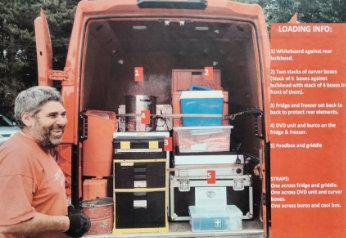
“Opening the rear of the van can be exciting” - please pack vans carefully and refer to this useful diagram attached to the back doors of each van, and make things easier for the Logistics team
Our roundup of progress on waterway restoration project around the country begins with a flurry of activity on the Sankey Canal…
There has been a flurry of activity by the Sankey Canal Restoration Society recently; we have conducted a number of work parties, which has concentrated on clearing shrubbery along the infilled section of the canal between Bradley Common Lock and Newton Common Lock. This is part of a program to reveal the line of the canal, which will assist in future work to reveal coping stones and allow new signs giving historical information. The society has also been working with the local Anglers’ Association to remove branches and debris from the stretch of canal that is still in water at Hey Lock. Members of the society have also met with Warrington North MP Charlotte Nichols to discuss how the canal can be utilised to ease the local flooding problems of Dallam and Bewsey in Warrington. The discussion was a positive one that ignited much local media attention and it is hoped that Ms Nichols will take these ideas further. As the society is in its 40th year, we have also been shaping plans for restoration in certain sections of the canal, something that we hope to reveal in future reports.
Dr David Harrison Secretary of the Sankey Canal Restoration Society

…and meanwhile the Shropshire Union Canal Society’s volunteers are making more progress on the length south of Crickheath Wharf
Shropshire Union Canal Society February 2025 work party report: “During this time 170 metres of channel has been cleared of scrub, 720 hedging whips have been planted, a further 74 metres of hedge has been laid, and bonfires have kept us warm during some very chilly weather”. Said Tom Fulda, restoration project manager, “And although spared the severe frost and ice of the January work party the weather on this occasion was still ‘uninviting’: damp and grey with a bonechilling easterly breeze”.
In addition to the environmental programme a further milestone was reached, not possible in the previous month’s freezing weather. Having first raised the level of the Phase 1A temporary dam [See map below for explanation of the phases] as mitigation against future storm surges the pipe connection between Phases 1A and 1B past the farm crossing was deployed. Although 1B had already accumulated a lot of rainwater since it was completed in July it has now filled completely. Approximately half the length of channel between Crickheath Bridge and Schoolhouse Bridge is now in water.

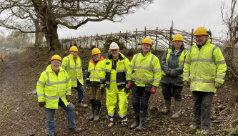
Beyond these rewatered sections work continued to profile the channel ready for lining next month (weather permitting). 100 metres has now been completed. The channel in this area widens on a bend and the offside bank is now slightly below the required height above water level. A further complexity is retaining sufficient material to create soft banks behind the retaining wall blocks [see May 24 work party report and back cover picture in Navvies 325]. There is more work to do profiling the channel in this area which may require some trial-and-error adjustment, but excellent progress has been made so far.
Aside from clearing, profiling and lining the channel there are always a multitude of other tasks required in support. Time was spent on Saturday cutting pegs from lengths of angle iron for securing towpath boards and, on Sunday, cutting lengths of lining materials ready for the next work party.
SUCS March 2025 work party report: Following the harsh weather conditions endured over the last three work parties, this time we were blessed by warm, spring sunshine. Ideal for lining the canal channel and blocking (laying concrete blocks over the waterproof liner).
Themain focus for this work party was to start lining and blocking a further section of prepared channel. This next section, the final part of Phase 1B, takes us a further 135 metres towards the Schoolhouse Bridge. Once complete, the remainder of the works will be undertaken from the Schoolhouse Bridge end of the site and we shall relocate to a compound by the bridge later in the year.
Many previous sections have benefited from access along a temporary haul road constructed on the opposite bank to the towpath, but for the remainder of this project we don’t have that luxury. Instead, materials are delivered to the work area along the bed of the channel. Just as well then that the site was dry – this volume of traffic would have created a quagmire in different circumstances. Volunteers adapted quickly to the change. No comments were heard lamenting the absence of the fabled block delivery chute (previously used to deliver blocks to the work area from the haul road) and by Sunday afternoon, a remarkable 47 metres of lining and blocking had been achieved. Over 3,500 blocks were used, each laid by hand. Blocks finish just below water level and admittedly the banks above water level still require completion, but nevertheless this is a work party record length, certainly for the current project and possibly the greatest of all time. (The
Crickheath
Bridge 85
Phase 1A
Phase 2
Phase 1B
Schoolhouse
Bridge 86 (rebuilt)
The Crickheath South Project is Shropshire Union Canal Society’s current project to clear, restore and (where necessary) re-line the canal from the current limit of navigation (since the 2023 reopening) at Crickheath Bridge to the recently rebuilt Schoolhouse Bridge. This length has been subdivided by SUCS into three phases, as shown in the detail map above.
Reopened in stages from Frankton to Crickheath1995-2023
Frankton To Hurleston Former Weston Arm To Llangollen
Maesbury
Crickheath
Current SUCS “Crickheath South” work site
Short restored length with tripboat at Llanymynech
Reopened in stages from Arddleen to Refail 1970s-2000
Three locks restored south of Refail but road blockages remain. Final length into Newtown blocked by sewer, terminus built on. Not planned for restoration but possible diversion to new terminus
current project manager is confident he will be corrected if this assertion is wrong).
Elsewhere, and after a long wait for suitable weather conditions, the haul road alongside the rewatered section completed last year was removed and the site restored to its original condition. Although still bare, these re-watered sections no longer look like a building site and will green up rapidly over summer. The banks will be re-seeded in the next few weeks with a blend of local native grasses and wildflowers.


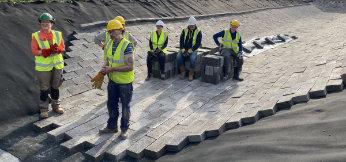
Meanwhile in Somerset, there’s progress being made on Terminus Bridge at Paulton Basin, not to mention the arrival of a ‘metal miner’…
There's been a lot going on down on the canal recently. The Somersetshire Coal Canal Society hosted a one-off Big Work Party on 13thApril, we had the official handover of the Metal Miner statue from the Somerset Miners Trustand we've also been lucky enough to have a new bench donated by a local resident after ours was vandalised last year.
BIG WORK PARTY - 13thApril 2025: Earlier in the year we decided to organise a oneoff work party with the aim of making some significant progress on the restoration of the abutment walls of Terminus Bridge at the Paulton end of the canal. We have been trying to restore the walls for a couple of years now, but we needed more people to push it along a bit. We put a call out on social media for help and asked all the people we knew if they could come along! We also asked local businesses if they could help. We carry out work parties every Sunday at Paulton, but the idea of a one-off work party was much more popular. As with any event, we had a lot of people pull out due to illness etc, and we also had a lot of people saying they may be able to come, so we weren't sure what would happen on the day! As it turned out, we had 23 volunteers turn up, all of whom were very enthusiastic and raring to go!
Local businessesdid not disappoint either.Robbie Allen Fireplaceswas the only professional stonemason we had volunteer, and he not only offered his time, but we learnt a lot from him too. Jewson Radstockloaned us a petrol stone cutter free of charge, we had cakes supplied byThe Fairy Cake House,Court Above The Cutcame along and filmed the event using their camera equipment and drone andThe Red Lion Paultoncooked all our food for us afterwards. Paul Gilbert Carpentry and General BuildingandDave Wordley Building & Maintenanceboth offered their skills for the day andStudio four point tenalso came along and helped with the labouring. All of this was free of charge.
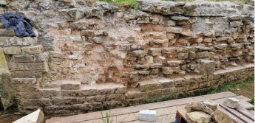
Before and after pictures showing good progress made on the Terminus Bridge abutments during the April Big Work Party
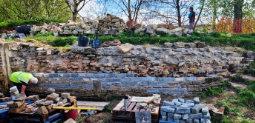
We had several new volunteers turn up, some of our regular volunteers and some from the Combe Hay Work Party came over to join us too. We cannot thank everyone enough; they all willingly gave up their time to help us. We were absolutely blown away with the turnout. We had so many volunteers that we managed to split off into different groups and did some tidying up work around the dry dock area as well as the work on Terminus Bridge walls. Due to the remote location of the canal, we had some challenges around parking. Two local residents kindly offered their driveways, so we had volunteers manning the parking areas with painted signs directing people to their parking. Even making the tea and coffee for breaktime was a challenge for 23 people!
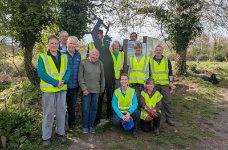
We made such fantastic progress on the walls that we are now considering another one-off session to get it over the finish line! Thank you to everyone that attended.
Metal Miner Official Handover: On top of our big work party on 13th April, we also had the pleasure of hosting Bryn Hawkins, Chair of the Somerset Miners Trust.
Bryn had this to say: Very often we hear people say “we didn’t know there were coal mines in Somerset”. This prompted the Somerset Miners Trust Trustees to act by installing metal miners near where coal mines existed. It’s very fitting one should be put near the loading point on the Coal Canal.
Bryn officially handed over the metal miner to the Somersetshire Coal Canal and its landowners, Brian Gould and his son Josh.
Bench handover: The bench at the Dry Dock near Paulton Basin was vandalised late last year. The bench was used frequently by walkers and the work parties and was sorely missed.
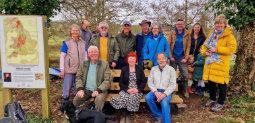
We are very pleased to announce that local councillor Liz Hardman, who supports our quest to restore the canal and frequently walks there, has donated the wood to build a new one for everyone to enjoy. Local group Midsomer Norton's Men's Shed have kindly built the bench and we've had it installed close to where the old one was situated.
A huge thank you to both Liz and The Men's Shed for their support. We are confident it will be appreciated and used by many in the years to come.
Tracy Craven Marketing Secretary Somersetshire Coal Canal Society
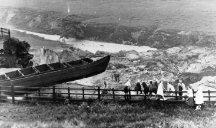
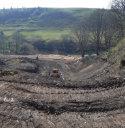

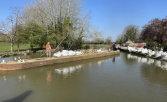
The 1936 breach (pictured top left) near Nob End which closed the Manchester Bolton & Bury Canal to all but very local traffic is finally being repaired (top right) by developers as a condition of planning permission for housing - let’s hope the recent breach on the Bridgewater Canal doesn’t take as long to fix! Meanwhile WRG Forestry are pictured (above left) clearing trees that were getting in the way of the Buckingham Canal restoration at Cosgrove: the logs are then sent by water (above right) by the hopper load to a farm at Gayton, earning money for further restoration work as well as putting a rare freight load on the Grand Union. Finally (below) NWPG volunteers are seen setting up a site compound at Rooks Hill ready for this summer’s Wey & Arun Canal Camps
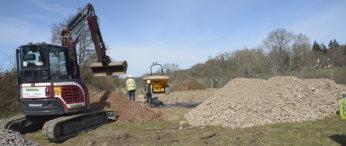
Date already decided for the BCN Cleanup 2026, possible WRG Reunion dig, and do you happen to be looking for some bentonite?
We are running three one day emergency first aid courses for free which will now also cover the additional forestry module (tourniquets, haemostatic dressings and tick bites). The location is Hinton Parva (just off M4 Junction 15, near Swindon) and the dates are 20th, 21st & 22nd September. If you would like a place please email me at bungle@wrg.org.uk and make sure your email includes your name and mobile number.
George ‘Bungle’ Eycott
In this issue you can read all about the successful annual Cleanup weekend held on the Birmingham Canal Navigations - but next year’s event is already being planned. The work site will be up on the northern reaches of the system, with the Daw End Branch Canal a likely venue, and that almost certainly means a change of overnight accommodation from our home for several years at the Malthouse in Tipton. So put the date - 14-15 March 2026 - in your diaries.
If you’ve been involved in WRG for more than five years or so, you’ll remember an annual event variously referred to as the Reunion or the Bonfire Bash. It took the form of a major working party, often attracting over 100 volunteers, usually working on a big scrub-bashing job (with some big bonfires, hence the name!) And it was also a good annual social get-together for WRG and other mobile volunteers. However since we took an enforced break during the pandemic we haven’t managed to organise a Reunion work party, for a variety of reasons including difficulty finding a suitable sized job, getting all the permissions in place, and booking large enough accommodation. But this year we might have found a suitable site. We should know for sure by the next issue, and will
hopefully be able to confirm the site and whether the date is on our traditional first weekend of November. Watch this space!

You may well be familiar with the Anderton Lift, Britain’s only surviving operable historic boat lift, which carries boats up and down 50ft between the Trent & Mersey Canal and the River Weaver. If you’ve been around for a while, you may recall that for a long time it couldn’t actually be called ‘operable’. Corrosion had rendered its steel structure unsafe, there weren’t the funds to repair it, there were concerns about whether and how it would be possible to restore it to operation without having to replace so much of its historic fabric that it couldn’t actually be called ‘historic’ any more, and so on…
In the end it was restored (and converted back to its earlier hydraulic system, which put less weight on its frame than the counterbalanced system which had been in operation in its later years) and put
back in operation in 2003. But this wouldn’t have happened without a 20 year campaign, led by the Trent & Mersey Canal Society with support from the Inland Waterways Association and many other groups - your editor is one of 20 WRG volunteers who abseiled down the Lift in 2001 to raise money and publicity.
A new 32-page booklet Anderton Boat Lift: the restoration campaign years 19832003 recounts the detailed year-by-year story of this 20-year campaign to save the Lift. It’s written and published by Sandy Wright, all proceeds go to the Trent & Mersey Canal Society, and it’s available for £5.50 including postage from trentandmerseycanalsociety.org.uk/shop.
Do you know a Breastock from a Bostock?
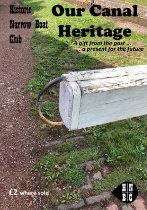
If you don’t (or even if you do), you might be interested in another new booklet, this time from the Historic Narrow Boat Club (HNBC).
It’s titled Our Canal Heritage, and subtitled “A gift form the past… a present for the future”. And the majority of its 48 pages are filled with glossaries of heritage canal terminology including working boat people’s names for objects and particular places, different boat types, parts of boats, boaters’ culture, and over 100 different parts of a canal lock.
There are also opinion pieces, discussions of the loss of heritage, boat handling, and how to balance saving heritage against safety concerns and standardisation resulting from a desire to save costs to cope with declining funding.
It’s based on a presentation given to the Canal & River Trust Council by two (then) elected members Ian ‘Mac’ McCarthy (representing volunteering) and Phil Prettyman (representing boating), and by the time this appears in print it will hopefully be available from hnbc.org.uk.
Oh, and a Breastock (also called a deck beam) is a curved beam along the back of boat’s foredeck which supports the deckboard (sometimes called the cratch) and stops lockage water from spilling into the hold. While Bostocks are the wooden beams in the bottom of a drydock that boats sit on while being worked on.
Buckingham Canal Society have secured 750 x 20kg of bentonite (clay material used for lining canals) at a very discounted price. They are happy to supply some of it to other societies at around 50% discount from commercial price. It would need to be collected from Cosgrove.
Contact Terry Cavender by email on terry.cavender@buckinghamcanal.org.uk to discuss.
We’re looking for people to help with a couple of behind-the-scenes non-physical jobs.
Firstly we would like somebody to help with putting our accident / incident / near miss forms online.
And secondly we’re looking for someone to help with putting together the IWA / WRG Practical Restoration Handbook, which was first published in the 1990s but is being rewritten. Book 1 is already complete and published, but we need help with Book 2 and Book 3.
If you can help with either of these tasks, please contact enquiries@wrg.org.uk.
…from the editor for the late arrival of this issue of Navvies. We hope to have it back on schedule by Issue 331.
